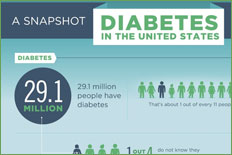Health Centers > Diabetes Center > Chronic Complications of Diabetes > Diabetes Ocular complications
Diabetes Ocular complications
1. Diabetic cataracts - Premature cataracts occur in diabetic patients and seem to correlate with both the duration of diabetes and the severity of chronic hyperglycemia. Nonenzymatic glycosylation of lens protein is twice as high in diabetic patients as in age-matched nondiabetic persons and may contribute to the premature occurrence of cataracts.
2. Diabetic retinopathy - Three main categories exist: background, or "simple," retinopathy, consisting of microaneurysms, hemorrhages, exudates, and retinal edema; preproliferative retinopathy with arteriolar ischemia manifested as cotton-wool spots (small infarcted areas of retina); and proliferative, or "malignant," retinopathy, consisting of newly formed vessels. Proliferative retinopathy is a leading cause of blindness in the United States, particularly since it increases the risk of retinal detachment.
Diabetes Chronic Complications
Ocular complications
L Diabetic cataracts
L Diabetic retinopathy
L Glaucoma
Diabetic Nephropathy
L Microalbuminuria
L Progressive diabetic nephropathy
Diabetic Neuropathy
L Peripheral neuropathy
L Autonomic neuropathy
Cardiovascular complications
L Heart disease
L Peripheral vascular disease
Skin and Mucous membrane complications
Special Situations
Prognosis
Vision-threatening retinopathy virtually never appears in type 1 patients in the first 3-5 years of diabetes or before puberty. Up to 20% of patients with type 2 diabetes have retinopathy at the time of diagnosis. Annual consultation with an ophthalmologist should be arranged for patients who have had type 1 diabetes for more than 3-5 years and for all patients with type 2 diabetes, because many were probably diabetic for an extensive period of time before diagnosis.
1. Diabetic cataracts - Premature cataracts occur in diabetic patients and seem to correlate with both the duration of diabetes and the severity of chronic hyperglycemia. Nonenzymatic glycosylation of lens protein is twice as high in diabetic patients as in age-matched nondiabetic persons and may contribute to the premature occurrence of cataracts.
2. Diabetic retinopathy - Three main categories exist: background, or "simple," retinopathy, consisting of microaneurysms, hemorrhages, exudates, and retinal edema; preproliferative retinopathy with arteriolar ischemia manifested as cotton-wool spots (small infarcted areas of retina); and proliferative, or "malignant," retinopathy, consisting of newly formed vessels. Proliferative retinopathy is a leading cause of blindness in the United States, particularly since it increases the risk of retinal detachment.
Vision-threatening retinopathy virtually never appears in type 1 patients in the first 3-5 years of diabetes or before puberty. Up to 20% of patients with type 2 diabetes have retinopathy at the time of diagnosis. Annual consultation with an ophthalmologist should be arranged for patients who have had type 1 diabetes for more than 3-5 years and for all patients with type 2 diabetes, because many were probably diabetic for an extensive period of time before diagnosis.
Avoiding tobacco use and correction of associated hypertension are important therapeutic measures in the management of diabetic retinopathy. There is no contraindication to using aspirin in patients with proliferative retinopathy.
The Hypoglycemic States
Spontaneous hypoglycemia in adults is of two principal types: fasting and postprandial. Symptoms begin ...
3. Glaucoma - Glaucoma occurs in approximately 6% of persons with diabetes. It is responsive to the usual therapy for open-angle disease. Neovascularization of the iris in diabetics can predispose to closed-angle glaucoma, but this is relatively uncommon except after cataract extraction, when growth of new vessels has been known to progress rapidly, involving the angle of the iris and obstructing outflow.


